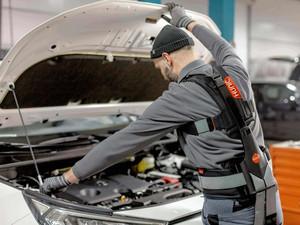KANBrief 2/23

Exoskeletons can assist workers with certain movements and postures. A number of DIN working groups have now been standardizing the properties, ergonomic requirements and test methods for exoskeletons for around two years.
Exoskeletons are technical systems worn on the human body. Coupled mechanically with human beings and interacting with them, they are able to support the latter in adopting defined body postures and performing defined movements. For example, some are designed to make it easier for workers to lift loads, by directing a part of the forces acting upon the body away from the lower back. Other exoskeletons support employees’ arms, particularly during prolonged work above shoulder level, thereby relieving the stress upon the shoulder and neck area. The intention is that the use of exoskeletons will reduce stress upon workers and avoid adverse consequences for their health in scenarios in which other measures are not effective.
Exoskeletons have not yet been adopted widely at workplaces. Development is nevertheless progressing, leading to a steady rise in the number of exoskeletons available on the market that can be used for a variety of purposes. Besides further research, particularly into the longer-term impact of exoskeletons, a need also exists for standards. These standards could formulate general, safety and ergonomic requirements for exoskeletons, and recommendations for their development and testing. The requirements set out in the standards provide clarity concerning the properties and possible applications of exoskeletons.
Standardization work on exoskeletons began in Germany in January 2021 with the establishment of joint working committee NA 023-00-08 GA: Exoskeletons at DIN. The Standards Committee Ergonomics, which holds overall responsibility, cooperates in the joint committee with the Standards Committee Mechanical Engineering (Robotics) and the Standards Committee Optics and Precision Mechanics (Orthopaedic technology). A broad range of stakeholders are participating in the work. These include representatives from the scientific and research community, the German Social Accident Insurance Institutions, the German Federal Institute for Occupational Safety and Health (BAuA), company employee representatives and a number of users. A representative of the KAN Secretariat also serves on the committee and provides support to the OSH stakeholders.
Joint working committee NA 023-00-08 GA: Exoskeletons has set up three working groups. The Structure and Terminology working group has developed a proposal for the classification of exoskeletons. The classification divides exoskeletons into the following areas of use: medical, commercial, military and private. It distinguishes between the form in which support is provided (e.g. facilitating or stabilizing movements), the type of drive (e.g. powered or non-powered), the body region supported (e.g. the lower back or shoulder and neck region) and the exoskeleton’s external geometry and structure (e.g. rigid or soft elements). In addition, this working group has formulated proposals for the definition of essential terms related to exoskeletons.
The Effectiveness and Comparability working group is defining parameters for exoskeletons, and test scenarios to ensure comparability between different exoskeletons. Parameters for comparability may include the exoskeleton’s inherent weight, the time required for donning and removal, and the battery power. Specified test scenarios may cover specific functions or activities performed with an exoskeleton, such as walking, sitting or climbing stairs. At the same time, the working group is developing standardized measurement procedures focused on the efficacy of the exoskeletons. The group draws attention to a number of measurement methods, such as electromyography (EMG), motion capture and force measurements, by which this can be tested.
The third working group, Physical Interface, is developing provisions and drafting the text of standards governing the human-exoskeleton interface. Since forces act through this interface on soft tissue of the human body, the ergonomic design of the interface is particularly important. It must be designed to prevent excessive pressure from being exerted. Mechanical hazards, such as crush and shear points, must also be considered and avoided. Finally, hygiene is a significant factor for the human-exoskeleton interface. Provisions are therefore also formulated for cleaning and care of elements of the exoskeleton that may come into direct contact with the human skin.
The aim of joint working committee NA 023-00-08 GA: Exoskeletons is to submit the provisions, work item proposals and draft texts to the European standardization process. Committees for this purpose have not yet been created. German representatives are therefore in contact with their counterparts in other European countries and are calling for European standards committees dealing with the subject of exoskeletons to be set up. Should enough countries express interest in participating, such committees could be constituted in 2024.
Ralf Schick, Head of the Physical Stresses subcommittee at the DGUV
r.schick@bghw.de